- In a mixing bowl, combine thinly sliced onions, minced green chilies, ginger, curry leaves, coriander, turmeric powder, baking soda, rice flour, whole wheat flour, and salt. Mix thoroughly with your hands.
- Gradually add water while kneading until a firm, cohesive dough forms.
- Heat oil in a deep frying pan over medium-high heat. Once hot, pinch small portions of the dough and gently drop them into the oil.
- Fry the fritters until golden brown and crispy, turning occasionally for even cooking.
- Remove with a slotted spoon and drain on paper towels. Serve warm with chai or chutney.
- Calories:150 kcal25%
- Energy:627 kJ22%
- Protein:2 g28%
- Carbohydrates:18 mg40%
- Sugar:3 mg8%
- Salt:100 g25%
- Fat:8 g20%
Last Updated on 2 months by Neha Deshmukh
Onion Pakora Recipe – Crispy Indian Fritters with Ginger & Chilli
Hello friends! There’s something so comforting about a plate of hot, crispy onion pakoras, especially with a cup of chai. Honestly, the smell alone takes me right back to monsoon evenings at my grandmother’s place. Today, I’m sharing my go-to recipe for these incredibly addictive Indian fritters – it’s super easy, and I promise, you’ll be making these again and again!
Why You’ll Love This Recipe
These aren’t just any pakoras. They’re perfectly crispy on the outside, soft and flavorful on the inside, and packed with the zing of ginger and chilli. Plus, they come together in under 30 minutes – perfect for a quick snack or when you have unexpected guests. They’re a real crowd-pleaser, trust me!
Ingredients
Here’s what you’ll need to make these delightful onion pakoras:
- 2 medium onions
- 2 green chillies
- 1 inch ginger
- 1 sprig curry leaves
- 2-3 tbsp chopped coriander
- 1/4 tsp turmeric powder
- 1/8 tsp baking soda
- 1/2 cup rice flour (approx. 70g)
- 1/4 cup wholewheat flour (approx. 30g)
- Salt to taste
- Oil for deep frying
Ingredient Notes
Let’s talk ingredients for a sec! A few little things make all the difference.
- Baking Soda: Don’t skip this! It’s the secret to achieving that light and airy crispness. It creates tiny bubbles in the batter, making the pakoras wonderfully crunchy.
- Oil for Frying: You can use any neutral-flavored oil with a high smoke point. Sunflower oil, vegetable oil, or even peanut oil work beautifully.
- Flour Variations: Traditionally, besan (gram flour) is used for pakoras, but I love the slightly different texture and flavour you get with a mix of rice and wholewheat flour. In some regions, you’ll find people using just rice flour, or even a combination of all three! Feel free to experiment and see what you prefer.
Step-By-Step Instructions
Alright, let’s get cooking!
- First, in a mixing bowl, combine the thinly sliced onions, minced green chillies, grated ginger, curry leaves, chopped coriander, turmeric powder, baking soda, rice flour, wholewheat flour, and salt.
- Now, get your hands in there! Mix everything really well, squishing the onions a bit to release their flavour.
- Gradually add water, a little at a time, while kneading until a firm, cohesive dough forms. You don’t want it too sticky or too dry – it should hold its shape.
- Heat oil in a deep frying pan over medium-high heat. To check if it’s ready, drop a tiny piece of dough in – it should sizzle and float to the top.
- Gently pinch small portions of the dough (about a tablespoon each) and carefully drop them into the hot oil. Don’t overcrowd the pan!
- Fry the pakoras until they’re golden brown and crispy, turning them occasionally to ensure even cooking. This usually takes about 3-4 minutes.
- Remove the pakoras with a slotted spoon and drain them on paper towels to remove any excess oil.
- Serve them warm – and get ready for compliments!
Expert Tips
- Don’t overmix the batter. A little bit of texture is good!
- Make sure the oil is hot enough before adding the pakoras. Otherwise, they’ll absorb too much oil and become soggy.
- Fry in batches to maintain the oil temperature.
- For extra crispy pakoras, you can add a tablespoon of cornflour to the batter.
Variations
Want to switch things up? Here are a few ideas:
- Vegan Adaptation: Just ensure the oil you use is vegan-friendly! Most vegetable oils are.
- Gluten-Free Adaptation: Simply use only rice flour – it works beautifully!
- Spice Level: Adjust the quantity of green chillies to suit your taste. My friend, Priya, loves to add a pinch of red chilli powder too.
- Festival Adaptations: These are especially popular during the monsoon season and Diwali. My family always makes a huge batch for Diwali celebrations!
Serving Suggestions
Onion pakoras are best enjoyed hot and fresh! They’re amazing with:
- A steaming cup of chai (Indian tea)
- Your favourite chutney – mint-coriander chutney, tamarind chutney, or even a simple tomato ketchup.
- A side of raita (yogurt dip) to cool things down.
Storage Instructions
Leftover pakoras can be stored in an airtight container at room temperature for a day or two. They won’t be as crispy, but you can reheat them in a preheated oven or air fryer to restore some of the crunch.
FAQs
Let’s answer some common questions:
- What is the best way to get the pakoras extra crispy? The baking soda is key! Also, make sure your oil is hot enough and don’t overcrowd the pan.
- Can I make the batter ahead of time? You can, but the pakoras will be crispiest if you fry them immediately after making the batter. If you do make it ahead, add the baking soda just before frying.
- What chutneys pair well with onion pakoras? Mint-coriander chutney is a classic, but tamarind chutney and even a simple tomato ketchup work great too!
- Can I bake these instead of frying? While you can bake them, they won’t get the same crispy texture as fried pakoras.
- What is the purpose of adding baking soda to the batter? It creates tiny bubbles, resulting in a light and airy, crispy texture.
Enjoy making these delicious onion pakoras! I hope they bring as much joy to your kitchen as they do to mine. Let me know how they turn out in the comments below!
Neha Deshmukh
Neha holds a B.A. in History with a focus on Indian and world history, including ancient, medieval, and modern periods. At RecipesOfIndia.org — the world’s largest database of Indian recipes — she combines her love for food and history by exploring how India’s past has shaped its culinary traditions.










